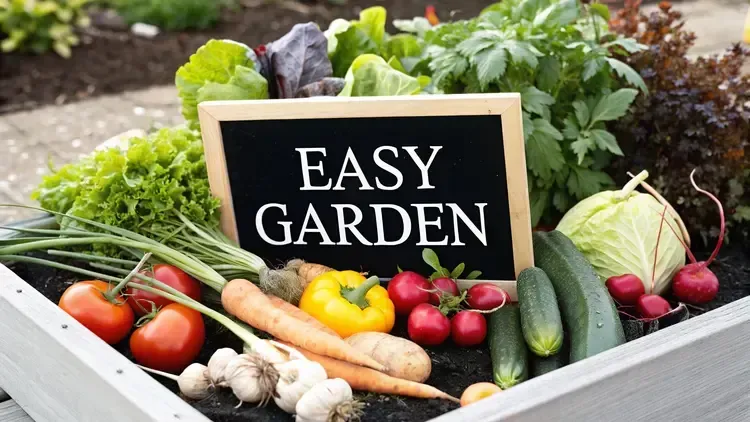
Top 8 Best Vegetables to Grow for Beginners in 2025
Top 8 Best Vegetables to Grow for Beginners in 2025
Dreaming of fresh, homegrown food but unsure where to start? The journey from a patch of dirt to a plate full of your own vegetables can feel daunting, but it doesn't have to be. The secret to a successful first garden lies in choosing the right plants, those that are forgiving, productive, and build your confidence with every sprout. This guide is designed to bridge that knowledge gap, turning your gardening aspirations into a delicious reality. We've curated a list of the best vegetables to grow for beginners, focusing on varieties that deliver a bountiful harvest with minimal fuss.
This is more than just a simple list. For each vegetable, we will provide specific, actionable advice to ensure your success. You will learn about:
Ideal planting times and soil conditions.
Spacing and depth requirements for healthy growth.
Watering and sunlight needs to avoid common mistakes.
Key troubleshooting tips for pests and diseases.
Forget the frustration of failed crops. By selecting from these reliable options like radishes, green beans, and zucchini, you set yourself up for a rewarding experience. It's time to get your hands dirty and watch your garden thrive.
1. Radishes
If you're looking for nearly instant gratification from your garden, radishes are the answer. These crisp, peppery root vegetables are among the fastest-growing plants you can cultivate, making them one of the best vegetables to grow for beginners. The incredibly short time from seed to harvest provides a quick, rewarding experience that builds confidence and keeps new gardeners motivated.
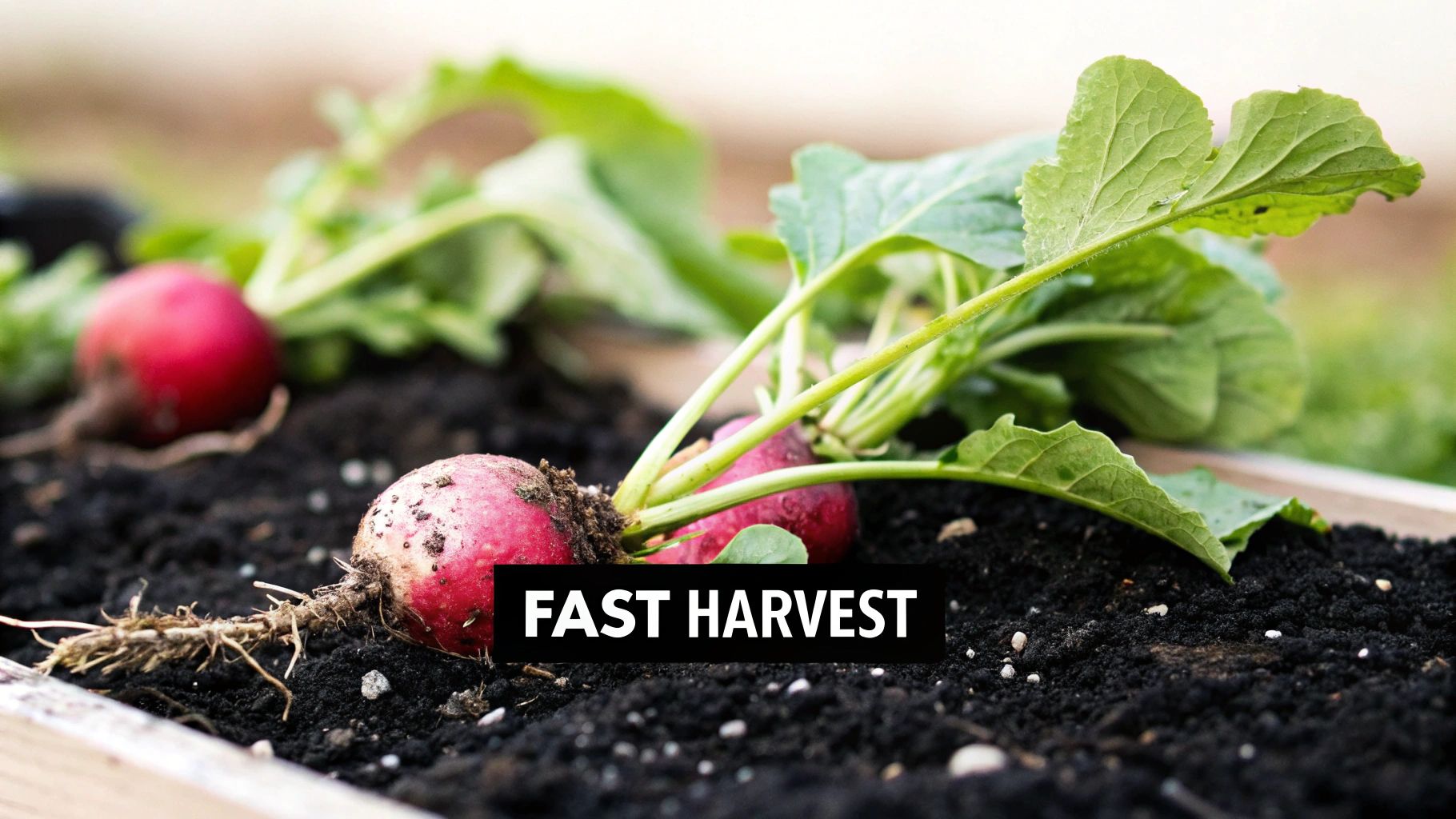
Unlike many vegetables that require months of care, some radish varieties can be pulled from the ground in as little as three weeks. This rapid turnaround is perfect for impatient gardeners or children, offering a tangible result almost immediately.
Why Radishes are Great for Novice Gardeners
The primary benefit is their speed. This fast growth cycle means you can see the fruits of your labor quickly, and if you make a mistake, it’s a low-stakes learning opportunity. You can simply clear the area and sow more seeds. Radishes are also relatively unfussy, tolerating a range of soil types as long as the soil is loose and drains well. Their compact size makes them ideal for small spaces, containers, and raised beds.
Key Tips for Radish Success
To ensure a bountiful and tasty harvest, follow these specific strategies:
Succession Planting is Key: For a continuous supply, practice succession planting. Sow a new row of seeds every 10 to 14 days throughout the cool spring and fall seasons. This prevents you from having a huge glut of radishes all at once.
Thin Your Seedlings: This is the most crucial step. Once seedlings are about two inches tall, thin them so they are spaced 1 to 2 inches apart. Crowded radishes will produce lush leaves but will not form proper roots.
Harvest Promptly: Check your radishes regularly once they hit the three-week mark. Harvest them when the roots are about the size of a large marble or gumball. If left in the ground too long, they become woody and unpleasantly spicy.
Utilize the Greens: Don't discard the leafy tops! Radish greens are edible and have a mild, peppery flavor. They are excellent when sautéed with garlic or added to salads and soups.
Recommended Varieties for Beginners:
Cherry Belle: A classic round, red variety ready in just 22 days.
French Breakfast: An oblong, two-toned radish with a mild flavor, maturing in about 28 days.
Daikon: A larger, milder winter radish perfect for fall planting. It takes longer (around 60 days) but stores exceptionally well.
2. Lettuce
Growing your own fresh, crisp salad greens is a simple pleasure that every new gardener should experience. Lettuce is one of the best vegetables to grow for beginners because it thrives in cool weather, grows relatively quickly, and can be harvested repeatedly for a long-lasting supply. Its adaptability to containers makes it perfect for gardeners with limited space, like on a patio or balcony.
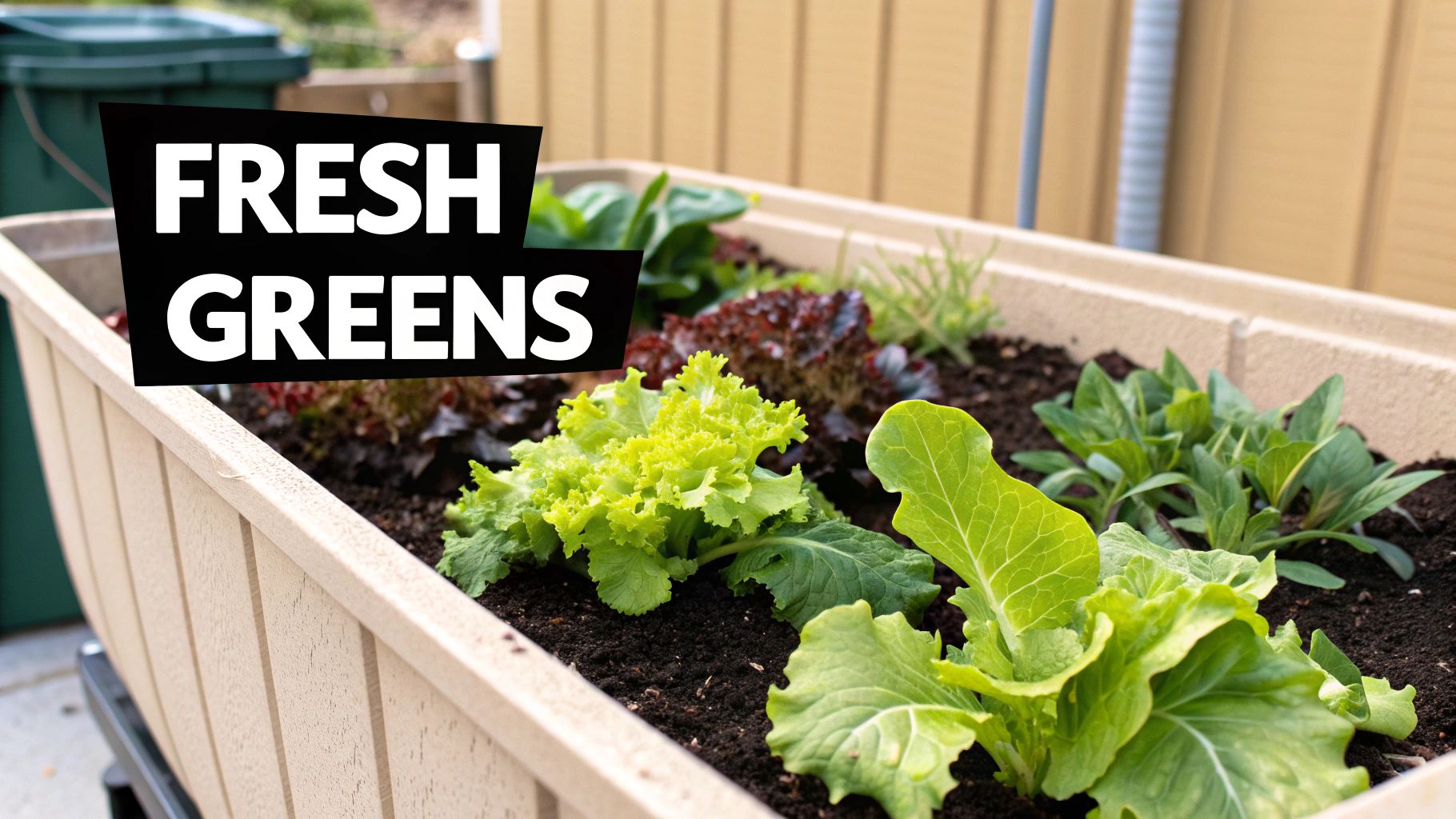
Unlike vegetables that produce a single harvest, many lettuce varieties are "cut-and-come-again," meaning you can snip off the outer leaves as needed and the plant will continue to produce more from its center. This provides a steady stream of fresh greens for weeks from a single planting.
Why Lettuce is Great for Novice Gardeners
Lettuce offers a high reward for minimal effort. It germinates easily and doesn't require the complex staking or pruning that other vegetables need. Because it prefers cooler temperatures, you can get a head start on the gardening season in early spring and enjoy a second harvest in the fall. The sheer variety, from loose-leaf types to crisp heads, allows beginners to experiment and find their favorites.
Key Tips for Lettuce Success
To cultivate lush, flavorful lettuce and avoid common pitfalls like bolting (premature flowering), follow these strategies:
Continuous Harvest Method: For loose-leaf varieties, harvest only the outer leaves once they reach about 4-6 inches long. This encourages the plant to keep producing new leaves from the center, extending your harvest season significantly.
Succession Planting: To ensure a constant supply, sow new seeds every 2-3 weeks. This staggers your crop, so you always have new plants ready as older ones begin to fade.
Provide Afternoon Shade: Lettuce can bolt and turn bitter in hot weather. Planting it where it will receive afternoon shade or using a shade cloth can keep the plants cool and productive for longer, especially as summer approaches.
Start Seeds Indoors: Get a jump on the season by starting seeds indoors 4-6 weeks before your last expected frost. This gives you strong, healthy seedlings ready to transplant as soon as the weather is suitable.
Recommended Varieties for Beginners:
Black Seeded Simpson: A fast-growing loose-leaf variety that can be harvested for over eight weeks.
Buttercrunch: A classic butterhead type that forms small, tender heads and is ready in about 65 days.
Red Sails: A beautiful loose-leaf lettuce with ruffled, reddish leaves that adds color to salads and matures in just 45 days.
3. Green Beans
For a harvest that is both reliable and abundant, green beans are a top contender. These productive plants are nearly foolproof, making them one of the best vegetables to grow for beginners. Not only do they produce generously with minimal care, but they also improve your garden's health by fixing nitrogen in the soil, which benefits subsequent crops.
Green beans come in two main types: bush beans, which grow compactly, and pole beans, which climb. This versatility allows gardeners to choose the best fit for their space, whether it's a large plot or a few containers on a patio.
Why Green Beans are Great for Novice Gardeners
Green beans are exceptionally forgiving and productive. A small patch can yield a surprising amount, providing a steady supply for weeks. Their nitrogen-fixing ability is a unique benefit, as they essentially fertilize the soil they grow in. This makes them a fantastic choice for new garden beds, improving soil structure for future plantings. They are also relatively low-maintenance once established.
For a quick reference, this summary box highlights the key data points for growing green beans.
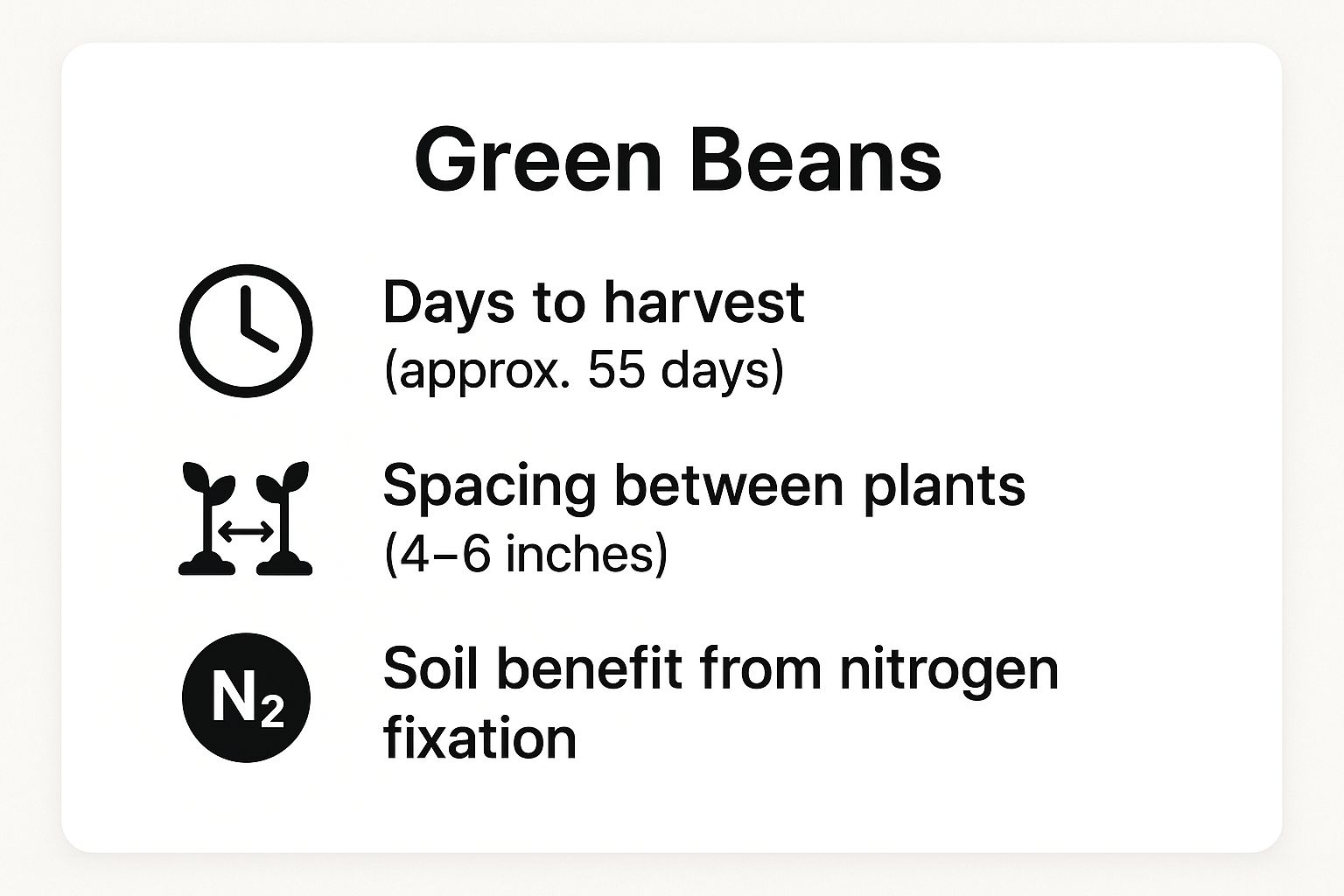
This data shows that green beans offer a relatively quick harvest and benefit the soil, all while requiring minimal spacing.
Key Tips for Green Bean Success
To get the most out of your green bean plants, focus on these essential strategies:
Plant at the Right Time: Wait until the danger of frost has passed and the soil has warmed to at least 60°F (15°C). Planting in cold, wet soil can cause the seeds to rot.
Harvest Frequently: This is the most important tip for a long harvest. Pick beans as soon as they reach a desirable size (typically the thickness of a pencil). The more you pick, the more the plant will produce.
Provide Support for Pole Beans: If you are growing pole varieties, install a trellis, pole, or tepee structure at the time of planting to avoid disturbing the roots later.
Consider Inoculant: For an extra boost, coat seeds with a rhizobia bacteria inoculant before planting. This enhances their natural nitrogen-fixing capabilities, leading to healthier plants and better soil. For a comprehensive guide, learn more about how to grow green beans at The Grounded Homestead.
Recommended Varieties for Beginners:
Provider: An incredibly reliable and early bush bean variety that produces well even in cooler soil, ready in about 50 days.
Kentucky Wonder: A classic, stringless pole bean that climbs over 6 feet and produces heavy yields of flavorful pods.
Royal Burgundy: A purple bush bean that is easy to spot among the green foliage, making harvesting simple. The beans turn green when cooked.
4. Tomatoes
No home garden feels complete without the classic tomato, and for good reason. The flavor of a sun-ripened tomato picked fresh from the vine is a world away from its store-bought counterparts. While some varieties can be finicky, many modern cultivars are specifically bred to be productive and resilient, making them one of the best vegetables to grow for beginners who want a truly rewarding harvest.
Starting with the right type, like a compact bush variety or a prolific cherry tomato plant, can make the process nearly foolproof. The satisfaction of slicing into your own juicy tomato makes the little bit of extra effort well worth it.
Why Tomatoes are Great for Novice Gardeners
Tomatoes offer an incredible return on investment. A single healthy plant can produce pounds of fruit throughout the season. They also provide a clear and tangible lesson in basic plant support and care. For new gardeners, choosing a determinate (bush) variety simplifies the process, as they grow to a manageable size, fruit all at once, and require less pruning than indeterminate (vining) types.
Key Tips for Tomato Success
To grow a bumper crop of delicious, unblemished tomatoes, focus on these essential strategies:
Plant Deeply: This is a crucial technique unique to tomatoes. When planting your seedling, remove the lowest sets of leaves and bury about two-thirds of the stem underground. The buried stem will sprout new roots, creating a stronger, more robust root system that is better at absorbing water and nutrients.
Provide Immediate Support: Don't wait for the plant to get large and fall over. Install a sturdy cage or stake at the time of planting to avoid damaging the roots later. Support keeps the fruit off the ground, improving air circulation and preventing rot.
Water Consistently and Mulch: Tomatoes are thirsty plants and hate inconsistent moisture, which can lead to blossom-end rot and cracked fruit. Water deeply at the base of the plant with a soaker hose or drip irrigation. Apply a thick layer of mulch (straw, shredded leaves) to retain soil moisture and suppress soil-borne diseases.
Start with Easy Varieties: Set yourself up for success by choosing beginner-friendly types. Cherry tomatoes are especially forgiving and productive.
Recommended Varieties for Beginners:
Cherry Tomatoes (e.g., Sungold, Supersweet 100): These are nearly foolproof, producing massive quantities of small, sweet fruits all season long.
Celebrity: A popular determinate (bush) variety that is disease-resistant, highly productive, and requires minimal staking.
Early Girl: An indeterminate variety famous for producing ripe tomatoes in as little as 50 days, giving you an early taste of summer.
5. Carrots
Pulling a perfect, bright orange carrot from the soil is one of gardening’s most satisfying moments. Carrots are rewarding root vegetables that teach beginners the crucial importance of soil preparation and patience. While they take longer to mature than radishes, they are relatively low-maintenance once established, making them one of the best vegetables to grow for beginners who want to try their hand at cultivating underground treasures.
The thrill of harvesting carrots comes from the surprise; you only know what you’ve grown once you pull them up. This makes them especially fun for families and gardeners who enjoy a sense of discovery. Modern varieties also offer a range of shapes and sizes, ensuring a carrot type for almost any garden space.
Why Carrots are Great for Novice Gardeners
Carrots are a lesson in soil health. They demand loose, well-draining, rock-free soil to develop straight roots, which encourages new gardeners to learn this fundamental skill from the start. They don't require much space and can thrive in deep containers or raised beds, which is perfect for urban gardening. Once seedlings are established, they are quite hardy and require minimal care beyond regular watering.
Key Tips for Carrot Success
To avoid forked, stunted, or disappointing carrots, focus on these specific strategies:
Improve Soil Structure: The number one rule for carrots is loose soil. If you have heavy clay, amend it generously with compost and sand to lighten the texture. This prevents the roots from struggling and splitting as they grow.
Soak Seeds Before Planting: Carrot seeds can be slow to germinate. To speed things up, soak the tiny seeds in water overnight before planting. This softens the seed coat and encourages quicker sprouting.
Thin Aggressively: Just like radishes, crowded carrots will not form proper roots. When seedlings are about two inches tall, thin them to a final spacing of 1 to 2 inches apart. It feels ruthless, but it's essential for a good harvest.
Practice Succession Planting: To ensure a steady supply, sow a new batch of seeds every two to three weeks during the cool spring and late summer months. A thoughtful approach to this is a key part of successful garden planning for beginners.
Recommended Varieties for Beginners:
Danvers: A classic, all-purpose carrot that is tolerant of heavier soils than other types.
Nantes: Known for their sweet flavor and nearly coreless, cylindrical shape. A great choice for most garden soils.
Paris Market: A small, round variety perfect for growing in shallow containers or rocky soil where long carrots would fail.
6. Spinach
Spinach is a nutritional powerhouse that's perfect for beginning gardeners seeking quick, healthy harvests. This cool-season green grows rapidly in the milder weather of spring and fall, providing essential vitamins and minerals with minimal fuss. As one of the best vegetables to grow for beginners, its ability to be harvested multiple times from a single plant offers a continuous reward for your efforts.
Unlike head lettuce which requires you to wait for a single large harvest, spinach can be picked leaf by leaf. This "cut-and-come-again" method means you can enjoy fresh greens for weeks, making it an incredibly efficient crop for small spaces and container gardens.
Why Spinach is Great for Novice Gardeners
Spinach thrives in the cool temperatures that can challenge other garden favorites like tomatoes and peppers. This allows new gardeners to extend their growing season into the early spring and late fall. It's relatively fast-growing, with baby leaves ready for salads in as little as 30 days. Its tolerance for partial shade also makes it versatile for gardens that don't receive full sun all day.
Key Tips for Spinach Success
To cultivate lush, tender spinach and avoid common pitfalls like bolting (premature flowering), follow these strategies:
Plant at the Right Time: Spinach is a cool-weather crop. Sow seeds directly in the garden 4 to 6 weeks before your last expected spring frost. For a second crop, plant again in late summer or early fall as temperatures begin to cool down.
Harvest Outer Leaves: For a continuous harvest, use scissors or your fingers to snip the outer, larger leaves from each plant. Leave the smaller, inner leaves to continue growing. This encourages the plant to keep producing for several weeks.
Provide Afternoon Shade: In warmer climates or as spring transitions to summer, intense afternoon sun can cause spinach to bolt, making the leaves bitter. Planting it where it will receive some afternoon shade can prolong your harvest.
Use Row Covers: Floating row covers are a beginner's best friend. They can protect young spring seedlings from a late frost and shield fall crops from pests and early freezes, effectively extending your growing season on both ends.
Recommended Varieties for Beginners:
Bloomsdale Long Standing: A classic, dependable variety with crinkled, dark green leaves that is slow to bolt in the heat.
Space: This smooth-leaf hybrid produces uniform, upright leaves that are easy to clean and grows well in containers.
Tyee: A highly bolt-resistant variety that is great for both spring and fall planting, known for its disease resistance.
7. Zucchini
Zucchini is famous for its prolific production and ease of growth, making it an excellent confidence-builder for new gardeners. This summer squash grows quickly in warm weather and can produce an almost overwhelming abundance of fruit from just a few plants. This high-yield nature teaches beginners about the incredible rewards of successful vegetable gardening.
Often, the biggest challenge with zucchini isn't getting it to grow, but rather figuring out what to do with all the fruit. A single plant can provide a steady supply for an entire family, making it one of the most productive and best vegetables to grow for beginners looking for a substantial harvest.
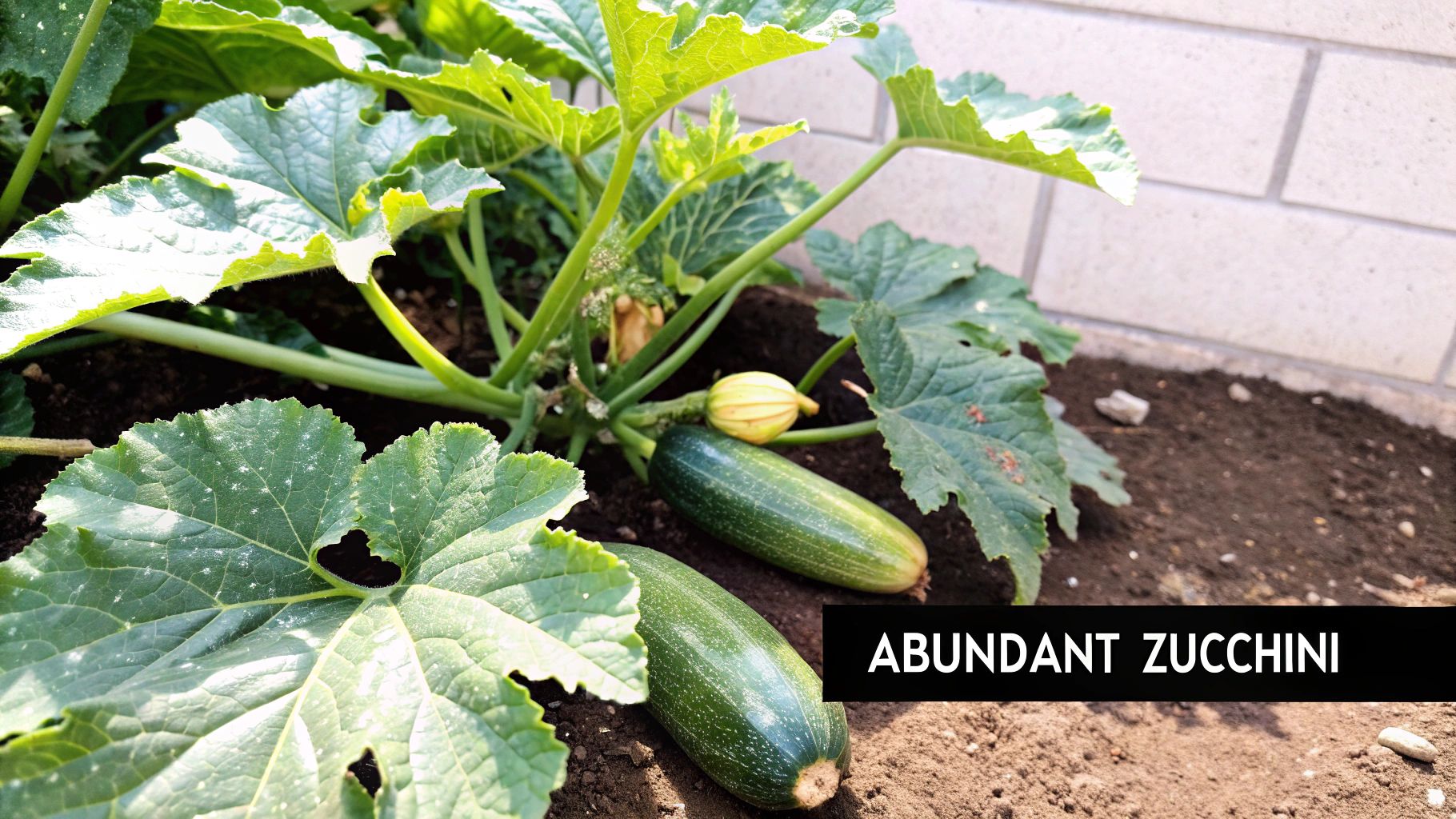
Why Zucchini is Great for Novice Gardeners
Zucchini plants are vigorous and relatively forgiving. They thrive in full sun and well-drained soil, quickly establishing themselves and beginning fruit production in just 45 to 55 days. Their large leaves help shade out weeds, reducing garden maintenance. Witnessing a small seed transform into a large, fruit-bearing plant in a short time is an incredibly satisfying experience for anyone new to gardening.
Key Tips for Zucchini Success
To manage its enthusiastic growth and ensure a high-quality harvest, follow these specific strategies:
Don't Overplant: For most families, one or two well-tended zucchini plants is more than enough. Planting too many will lead to an unmanageable glut of squash by mid-summer.
Harvest Frequently and Small: The ideal zucchini is 6 to 8 inches long. Check your plants daily during peak season, as they can double in size overnight. Smaller fruits are more tender and flavorful.
Prevent Pest Issues Early: Use floating row covers over your young plants to protect them from pests like squash vine borers. Remove the covers once the plants begin to flower so bees can pollinate them.
Consider Hand Pollination: If you notice flowers dropping without producing fruit, it may be due to poor pollination. You can easily transfer pollen from a male flower to a female flower (the ones with a tiny zucchini at their base) using a small paintbrush. For more details, explore these tips for zucchini care and harvesting on thegroundedhomestead.com.
Recommended Varieties for Beginners:
Black Beauty: A classic, dependable heirloom that produces dark green, glossy zucchini.
Costata Romanesco: An Italian heirloom with a nutty flavor and distinct ribbed appearance.
Eight Ball: A fun, round variety that is great for stuffing and grows on a more compact, bush-like plant.
8. Cucumbers
For a truly rewarding summer harvest, cucumbers offer a satisfying crunch and incredible versatility. Growing these vining plants is a classic gardening experience, and many modern varieties are bred for disease resistance and high yields, making them some of the best vegetables to grow for beginners. The feeling of picking a crisp, cool cucumber straight from your own garden on a hot day is a simple pleasure that keeps new gardeners coming back for more.Cucumbers are prolific producers, meaning even just a few healthy plants can provide a steady supply for your family's salads, sandwiches, and pickling jars all season long. Their vigorous growth is exciting to watch, transforming from small seedlings to sprawling vines in just a few weeks.
Why Cucumbers are Great for Novice Gardeners
The biggest draw for beginners is their productivity. It is deeply satisfying to harvest handfuls of fruit from a plant you've nurtured. Cucumbers are also adaptable; you can let them sprawl across the ground or, to save space and improve plant health, train them to climb a trellis. Growing vertically keeps the fruit off the soil, resulting in cleaner, straighter cucumbers and better air circulation to prevent common fungal diseases.
Key Tips for Cucumber Success
To get the most out of your cucumber plants, follow these specific strategies:
Go Vertical: Provide a sturdy trellis, cage, or fence for vining varieties. This is not just a space-saver; it promotes healthier plants by increasing airflow and makes harvesting much easier. The cucumbers will hang down, growing straighter and cleaner.
Consistent Watering is Critical: Cucumbers are over 90% water, so they need consistent moisture to produce well-formed, non-bitter fruit. Water deeply at the base of the plant to keep the leaves dry, which helps prevent powdery mildew.
Feed Them Well: These are heavy feeders. Amend your soil with plenty of compost before planting. Once the plants start to flower and produce fruit, give them a boost with a balanced liquid fertilizer every few weeks.
Harvest Frequently: Do not let cucumbers grow into giant, yellow blimps. Pick them when they reach the size recommended for the variety. Frequent harvesting encourages the plant to produce more fruit. Leaving an oversized cucumber on the vine signals the plant to stop production.
Recommended Varieties for Beginners:
Bush Slicer: A compact, bush-type plant perfect for containers or small gardens, producing full-sized slicing cucumbers.
Marketmore 76: A classic, dependable vining variety known for its disease resistance and productive, straight fruit.
Boston Pickling: An heirloom favorite that produces short, blocky cucumbers ideal for making pickles. They are ready to pick when small.
Top 8 Beginner Vegetables Comparison

Your Grounded Homestead Starts Today
You have now explored a curated collection of the most reliable, rewarding, and best vegetables to grow for beginners. From the rapid gratification of harvesting radishes in just a few weeks to the satisfying crunch of homegrown carrots, each plant we've covered offers a unique entry point into the world of gardening. You’ve learned that success isn’t about having a "green thumb," but about understanding the fundamental needs of your chosen plants.
The journey from a curious beginner to a confident gardener is paved with small, deliberate actions. Remember the core principles woven throughout this guide: consistent watering, adequate sunlight, and healthy soil are the pillars of a thriving garden. Whether you’re working with a few pots on a balcony or a dedicated plot in your backyard, these principles remain the same.
Your First Steps into Gardening
The most significant takeaway is that you don't need to master everything at once. The path to growing your own food is a process of joyful experimentation and learning. To translate your newfound knowledge into action, here are your immediate next steps:
Select Your Starters: Choose just two or three vegetables from our list that genuinely excite you. Are you dreaming of fresh salads? Start with lettuce and spinach. Craving homemade pasta sauce? Tomatoes are your go-to.
Assess Your Space: Take an honest look at your available sunlight. Track it for a day to see which spots get at least six hours of direct sun. This single step will dramatically increase your chances of success.
Gather Basic Supplies: You don’t need an arsenal of expensive tools. A quality potting mix, a few containers or a small prepared bed, a watering can, and your chosen seeds are all you need to begin.
Beyond the First Harvest
Embracing this process does more than just fill your plate with fresh produce; it connects you to the rhythm of the seasons and the satisfaction of self-sufficiency. Each successful harvest, no matter how small, builds confidence and provides invaluable, hands-on experience. You’ll learn to spot the first signs of pests, understand the subtle language of wilting leaves, and feel the immense pride of serving a meal you grew yourself. These are the foundational skills that can lead to a more sustainable and grounded lifestyle. Don't wait for the "perfect" time or the "perfect" setup. The best time to plant a seed was yesterday; the next best time is right now.
Ready to dig deeper and get personalized guidance on your gardening journey? The Grounded Homestead offers comprehensive courses and a supportive community designed specifically for beginners. Visit The Grounded Homestead to access resources that will help you cultivate a productive garden and a more self-sufficient life, one seed at a time.


Facebook
Instagram
X
Youtube